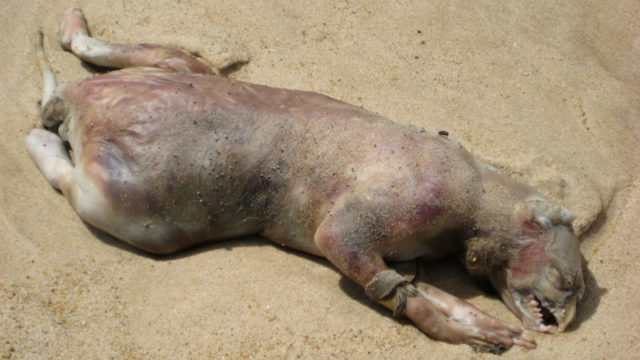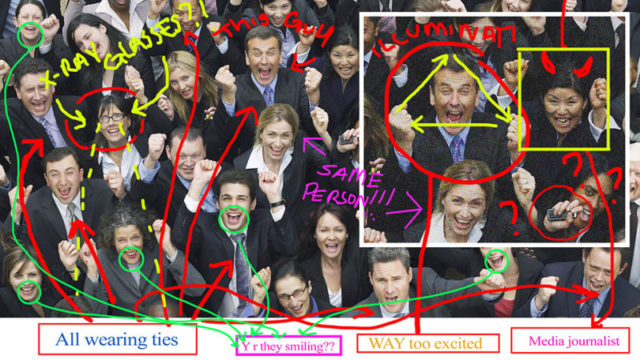
The Montauk Monster
For those of us who started and maintained blogs in the mid aughts, yesterday’s closure of Gawker wasn’t easy to watch. A year ago, I published a list of art blogs and magazines with Corinna Kirsch, full of headings modified with words like “active,” “not-active,” “defunct,” and “deleted.” It was already the end of an era then. Now, with the demise of the largest and arguably the most pioneering of blogs, I find myself wondering who amongst us will be left standing.
That question probably sounds pretty hyperbolic given the particular set of circumstances. Gawker, having published a number of unflattering posts about billionaire VC and Paypal founder Peter Thiel and his silicon valley colleagues, became the target of numerous lawsuits underwritten by Thiel. The one that sunk the ship—over a post containing a reflection on why we like to look at celebrities fucking and a clip from a sex tape featuring the famed pro-wrestler Hulk Hogan—won a hundred-and-forty-million dollar judgement. Most of us in publishing simply won’t have this particular set of problems.
We will, however, likely suffer through some permutation of them. Regardless of the merits of this particular case, almost every media property has been sued for warrantless reasons. It’s not even that uncommon that these cases be bankrolled by people with financial interests in the cause. In the art world, that most often translates to suits over authentication claims. Even when unsuccessful they can bankrupt companies and distort art history. But this may ultimately be trivial compared to what can be done in the political arena. Today, the New York Times reported that Charles J. Harder, the same lawyer engaged by Thiel in the Gawker case, is representing Melania Trump in her defamation suit against the Daily Mail. Thiel is an outspoken Republican and supporter of her husband and GOP presidential candidate, Donald Trump.
For Gawker’s critics this may not seem so significant. My Facebook feed is filled with friends who feel the blog’s shuttering marks the end of a needlessly malicious style of reporting that never needed to exist in the first place. And in a lot ways, those critics aren’t wrong. Gawker may not have single handedly pioneered a lot of the biting commentary that proliferated early blogs—in many ways, the early blog community was just a slowed down version of Facebook commenting—but they were often amongst the meanest. I watched them both celebrate and take-down minor celebrities with fervor—it was often enjoyable, but not always pretty—and plenty of personal friends got stung in the process.
Still, at a time when the mainstream gossip press seemed to be taking Paris Hilton’s nightlife activities seriously, sites like Gawker added some much needed levity to the reportage. The Gawker Stalker map allowed readers to instantly give the whereabouts of celebrities, and when regular news dried up, they made their own. For example, in 2008, the site dedicated weeks of enthusiastic summertime coverage to “The Montauk Monster,” an unidentified animal that looked just like a prehistoric sea-creature that had washed up on the shores of Montauk. It turns out the monster was just a dead dog, but I’d spent more time than I care to admit delightfully speculating on the identity of this hell demon.

From Sam Biddle’s essay on Chart Brut
I read these articles casually, but I began reading Gawker more seriously for their pieces that reflected on Internet aesthetics. Sam Biddle’s article naming Chart Brut, an exploration of conspiracy theory aesthetics, led me to contact more than one folk art expert. (None saw the connection to art brut, but I loved the article anyway.) Andy Cush’s profile on Seedfeeder, Wikipedia’s most prolific wikipedia sex illustrator, not only introduced me to a new artist, but made me think about instructional sex imagery from an art perspective. (I was quoted in that piece.) And Adrian Chen’s look at Brad Troemel’s Etsy store produced the clearest definition of conceptual art I’ve read to date. “Art is a conceptual way of making something that already exists more valuable and culturally relevant,” Troemel flatly told Chen.
Of course, the regular snarky coverage continued along with the more serious articles. Like any troll, Gawker claims their targets deserve it. Their version of this defense is that they tell the truth and call bullshit when they see it. Sure, they were mean, but never dishonest. As has been noted elsewhere, the belief in truth telling at all costs may be a sign of writers too wrapped up in their own bullshit to be able to identify it. Later, in this same post, this point is countered with the observation that given our current electoral climate, we need publications like Gawker more than ever.
But is that true? The Daily Dot, in its roundup of Gawker offenses, wrote that “large chunks of Internet culture need to be cleansed of their filthier, less morally sound components if they can hope to survive at all.” I read this as an indictment of blogs in general, which may answer Tom Scocca’s question about why the New York Times, which has committed far worse deeds, has never had its right to exist questioned. It’s not a blog and unlike Gawker it has an institutional voice and an archive that spans more than 100 years. Gawker (like AFC) is defined by its writers and its sensibility—its identity is amorphous and therefore easy to poke holes in. By contrast there is little flexibility in the history, and the authority that comes from it, that defines the Times.
To my mind, both of these qualities are essential to a functioning media ecosystem, but neither feel particularly urgent right now, perhaps because they do not answer our current problems. We live in a time where media companies, individuals and even presidential candidates proffer lies and half-truths in service of opportunistic grabs at money and power. People’s worst fears are exploited for political gain, conspiracy theories are mainstreamed and violent action upon these theories are encouraged by political figures. In this environment, truth tellers can hardly be identified, let alone heard.
We don’t need any more commentary on the commentary. We need to be holding people accountable and setting standards in political and media fields alike. For media companies, that means eliminating the bottomless pit of half-reported, slanted garbage that gets produced every day and figuring out how to hire back the fact-checkers that none of these media companies can afford—with or without Thiel-backed lawsuits. For politicians it means finding ways to connect with the people they serve and finding meaningful ways to improve their lives. And for all of us, it means figuring out a way to keep free-speech bullies like Thiel out of our courts. He’s a threat to the health of the democratic discourse, and anyone who thinks otherwise has let his bullshit go unchecked.


Comments on this entry are closed.